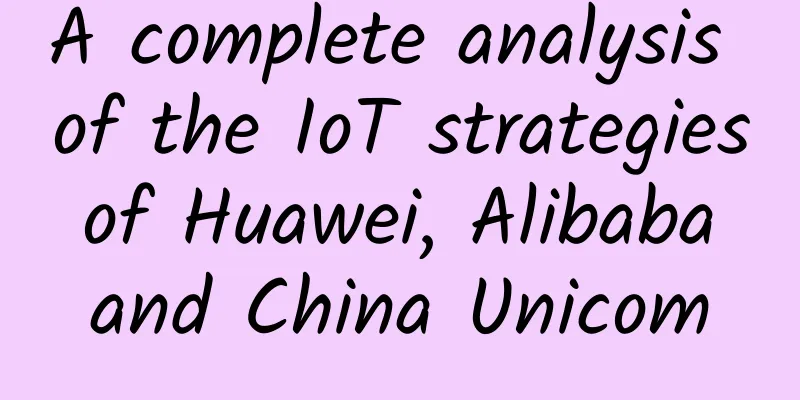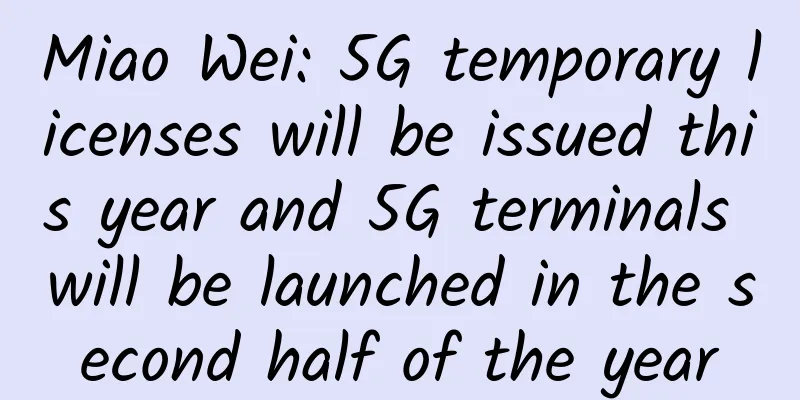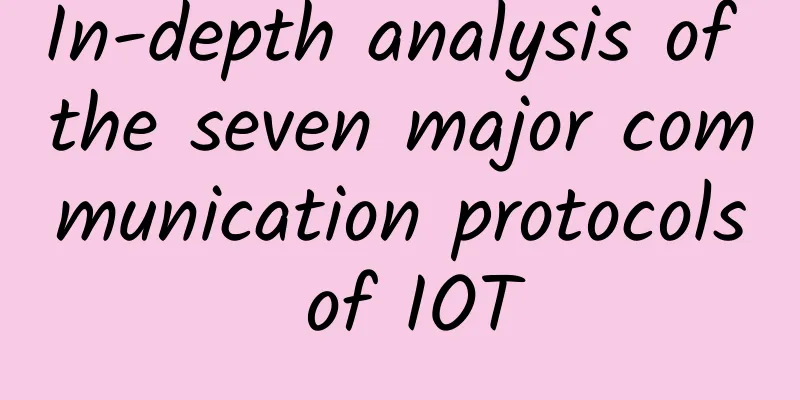A complete analysis of the IoT strategies of Huawei, Alibaba and China Unicom

|
Have you paid attention to the wave of "bombing" against 5G in the industry at the end of April? Operators have successively released 5G deployment strategies and demonstrated vertical industry applications in large-scale conferences.
The release of the 5G strategy also means that operators have officially entered the IoT race. Continuing to meet the needs of mobile communications between people is no longer the breakthrough point of 5G. The breakthrough point of 5G lies in IoT. Whether we can effectively promote the development of IoT and allow enterprises in vertical fields to deeply participate in the planning and construction of 5G networks will become the key to success in the 5G era. However, seeking development in the IoT track requires not only perseverance in the long run, but also the ability to integrate various technologies and the charisma to coordinate upstream and downstream companies in the industrial chain. The "difficulty coefficient" is unprecedented. How to cope with the high-difficulty challenges of IoT? The development strategies of giants in the field of IoT deserve in-depth analysis. So in this article you will see:
1. How will China Unicom’s IoT grow in the future? China Unicom’s IoT development strategy is very representative. Regarding China Unicom’s 5G Innovation and Development Summit, an industry insider commented that “it feels like China Unicom has put in all its efforts.” In order to become a "testing ground for new blue oceans and an incubator for unicorns", China Unicom has established the "China Unicom 5G Application Innovation Alliance" with 32 partners. Its mission is to: incubate industry application products; research business innovation models; promote the formulation of industry standards; build a capital cooperation platform; and jointly promote product markets. Innovative applications focus on key IoT industries, such as industrial Internet, smart transportation, smart cities, smart healthcare, smart energy, etc.
In the 5G era, the economic benefit model of network construction will be completely broken, and a new business model is taking shape. Therefore, China Unicom proposed a very forward-looking "three-in-one" business cooperation paradigm, namely: joint application development, joint investment, and joint operation. The premise for the successful implementation of this business model is that China Unicom can work with its partners to explore new industrial development space, new customers in existing industries, or new growth cases for existing customers. Everyone should work together to increase growth, so as to promote the willingness of multiple companies to cooperate and get higher returns. Taking the fire protection sector as an example, China Unicom selected leading players in the industry, such as Zhongxiao Cloud and Huawei, to jointly release the IoT OS white paper and the commercial version of the smart smoke sensor solution. Zhongxiao Cloud is a company that focuses on the research and development and manufacturing of fire protection IoT equipment, the construction and operation of fire protection cloud platforms, and the mining and application of fire protection big data. This public version of the smart smoke sensor solution defines the relevant functions of smoke sensor products, greatly accelerating the implementation of smoke sensor projects and the transformation and upgrading process of traditional smoke sensor companies, and promoting the large-scale implementation of smoke sensor products and solutions. In addition, China Unicom also started from the upstream and released the "China Unicom 5G Industry Terminal Overall Technical Requirements White Paper" and the "5G General Module White Paper" with Qualcomm, MediaTek, Huawei HiSilicon, Ziguang Spreadtrum, Quectel, and other companies. According to the advancement plan:
These practices show that in order to solve the problem of fragmentation in the IoT field and the generally long project implementation cycle, China Unicom is trying to connect the IoT field - the entire industrial chain spanning from chips, modules, terminals, platforms, applications to services. Specifically in terms of business models, China Unicom proposed three major categories, namely: smart connection + traffic products, network integration + operation product services, and open platform + application products. 1. Smart connection + traffic products: This model is the most well-known to everyone, similar to "recharge your phone bill and get a mobile phone for free." In the early stage of 5G, the standard model of the 4G era will continue, and traffic will be priced based on usage. However, in the 5G era, traffic will be further subdivided, such as real-time traffic and non-real-time traffic, or reliable traffic and unreliable traffic. The value of traffic may be evaluated and priced based on the quality, speed and reliability of data transmission. However, this business model still has not broken away from the operators' thinking habits. Judging from existing cooperation cases, although 5G application scenarios are gradually shifting to B2B, and network value and network characteristics will better meet B2B needs, the business model has not yet transcended the various variations of "recharge your phone bill and get a mobile phone for free." 2. Network integration + operation product services: Gartner research points out that the revenue potential of 5G is the development of network slicing. This requires understanding what network slicing is. Network slicing is an on-demand networking method that allows operators to slice multiple virtual end-to-end networks on a unified infrastructure to adapt to various types of business applications. There are two key points to understand slicing: one is a specific private network, and the other is the same infrastructure. The use of network slicing creates a very attractive business scenario: facing complex and diverse industry users, slicing provides telecom operators with a key to customize various specific "exclusive" networks for users, making the network a service (Network as a Service, NaaS). There are three ways of providing network slicing that are often discussed, namely:
As partners have the opportunity to be granted deeper network operation rights, network construction driven by industry enterprises is likely to emerge, and vertical field users will participate in 5G application scenario planning at an earlier stage. However, some industry insiders believe that this business model still does not break away from the operators' "pipeline thinking". In the past, they simply sold voice/traffic, and in the 5G era, they sell network slices, and the essence has not changed. 3. Open platform + application products: This business model is quite challenging and requires the integration of the entire industrial chain. For example, Taobao, Facebook, and APP Store can all be considered open platforms. On open platforms, the charging model for applications is changing. In the past, software and applications were charged by license, but now more and more applications are charged by subscription. These new SaaS applications demonstrate value by better meeting existing needs or stimulating new needs and scenarios. In this model, various companies such as modules, terminals, platforms, applications, and services work together to develop or provide applications and services based on open platforms for connected devices and related data for users to use, and complete the business loop in the process. Although this business model is full of imagination, some researchers believe that under the open platform model, value creation and value realization are separated. In other words, the entity that creates value does not necessarily gain commercial benefits. No matter which business model will ultimately show the most vigorous vitality, China Unicom has conveyed its sincerity in its IoT development strategy. With the concept of "cooperation without limits, building a new ecology together", there are no limits on the content and fields of cooperation, creating a testing ground for the new ecology. Whether China Unicom's IoT development strategy can be effectively promoted and implemented remains to be seen:
The road ahead is full of challenges. 2. Huawei IoT drives digital transformation of the industry Nowadays, there are many "players" competing in the IoT track, and it is a big topic to discuss in detail. In order to help you better refine the development strategies of the giants in the field of IoT, here we only use two typical companies as examples: Huawei, representing ICT companies, and Alibaba, representing Internet companies. At the end of 2017, Huawei defined a new vision closely related to IoT: "Bringing the digital world to everyone, every home, and every organization, and building an intelligent world where everything is connected." In March 2018, Alibaba announced its all-out entry into the Internet of Things, and IoT quickly became the fifth major track at the Alibaba Group level. Since then, the two companies have been competing with each other in the field of IoT. Based on the traditional advantages accumulated over the past years, they have promoted the transformation of vertical field infrastructure as a starting point to reconstruct application systems, reconstruct cooperative relationships and integrate business models. Here, we might as well start from the two basic dimensions of partnership and business model to observe the two companies' positions in the IoT track. Let’s look at Huawei first. In 2018, Huawei also targeted vertical fields such as smart cities, industrial Internet, smart homes, and smart connected cars, but its approach and depth of coverage in each field were different. 1. First of all, in the fields of smart public utilities, smart environmental monitoring, asset tracking, etc., Huawei's strategic positioning is to focus on infrastructure such as chips, networks, and platforms to help partners build a relatively complete ecosystem. In June 2016, the core protocol of the narrowband cellular Internet of Things NB-IoT standard was frozen. The technical advantages of NB-IoT are wide coverage and low power consumption, and the key to achieving these two goals lies in the terminal chip, which is the core technical difficulty of the entire industry chain. Once the NB-IoT chip reaches mature commercial conditions, it will play a huge role in promoting application innovation in the entire downstream industry. Therefore, Huawei's strategy is to use the IoT PaaS platform as a starting point, to gather the ecosystem with chips and LiteOS in the south, to empower various applications with the platform in the north, and to connect them with powerful pipelines in the middle, without touching module research and development, terminal equipment, equipment sales, application development, system integration and other links. Judging from the current situation, NB-IoT has indeed achieved rapid development. We often hear that in 2018, NB-IoT completed the development of 2G network in 6 years in just one year. Now NB-IoT is becoming the basic configuration of smart cities. 2. Secondly, in the fields of smart parks, industrial Internet, smart security, etc., Huawei has entered into terminal fields such as edge computing equipment, smart security cameras, and smart home connection hardware, and strategically entered into equipment research and development, terminal sales, system deployment and other links, and developed collaboratively with various partners in the game. Taking edge computing devices as an example, 2019 is the first year of 5G commercialization. Under this trend, Huawei is making a larger layout in edge computing servers to meet the needs of 5G mobile edge computing MEC. In this process, Huawei not only needs to adapt to the overall development of edge computing and develop products with higher performance and lower costs, but also needs to continuously make technological breakthroughs and innovations and use the functions and performance of software to demonstrate its competitive advantage. For example, at the end of 2018, Huawei announced that it would open source part of the intelligent edge computing service IEF on the public cloud, and contributed the edge computing management framework KubeEdge to help various industries accelerate their migration to cloud native. Let's take the edge hardware industry chain in a certain vertical field as an example. By analyzing the value and profit distribution of each link, we can see that Huawei's strategy of integrating software, hardware, and platform is not only conducive to commercial success, but also the synergy created can increase profit returns. 3. In the field of intelligent connected cars, Huawei finally announced its automotive strategy and positioning in early April this year. This time, Huawei's attitude is different from the past, and it debuted as a Tier 1. Tier 1 means the first-tier supplier that supplies equipment manufacturers. In other words, Huawei positions itself as an automotive parts supplier that directly supplies products to vehicle manufacturers. "For future electric vehicles with self-driving capabilities, except for the chassis, four wheels, shell and seats, the rest are all technologies we own," Huawei's rotating CEO said internally. In the field of intelligent vehicles, Huawei has carried out a comprehensive layout of chips, modules, terminals, pipelines, and cloud platforms to build a closed loop for the entire industry, becoming one of the few C-V2X manufacturers in the world that can provide a full range of solutions covering "chip-end-pipe-edge-cloud". Chip, Huawei has the world's most multi-mode chip that supports V2X, the Balong 5000; module, Huawei launched the industry's first 5G vehicle-mounted module MH5000; pipeline, Huawei has mastered 5G technology and network; cloud, Huawei has the OceanConnect Internet of Things platform. In addition, Huawei is one of the initiators of the C-V2X standard and is deeply involved in the Ministry of Industry and Information Technology's "2019 Internet of Vehicles (Intelligent Connected Vehicles) Standard Project Plan". Why is the field of smart connected cars so different? Because smart cars may replicate the glory of smartphones in the mobile Internet era and become an indispensable tool for people in the IoT era. Unlike the fragmentation dilemma faced by IoT in other vertical industries, the automotive market is highly concentrated and relatively easy to standardize, which is most suitable for Huawei's strategy of selecting and focusing on the main channel and continuously charging in the same direction. IHF, a US consulting firm, has predicted that global smart car sales will exceed 10 million by 2035. McKinsey predicts that the market size of smart cars will reach 1.9 trillion US dollars in 2025. As far as the Chinese market is concerned, the face of Chinese transportation may be completely changed in 20 years. By 2040, 55% of passenger miles will be used for electric vehicles, self-driving cars and shared cars. As the automotive industry shifts to electric vehicles and self-driving cars, China is likely to dominate. Huawei's strategies for fragmented markets, block markets, and highly concentrated markets are quite different. Due to the different depths of involvement, Huawei's partnerships with partners in various vertical fields are naturally different. Here is a simple summary using a picture. In many areas, Huawei has been very restrained and has given up many possibilities for development. However, every time Huawei lists "what not to do", it shows more of its thinking and determination to keep "what to do". This kind of determination after giving up is also the inevitable result of Huawei's outstanding achievements in many fields. 3. Alibaba IoT, building a business operating system Let’s look at Alibaba again. As a typical representative of Internet companies, Alibaba has its own unique perspective on IoT. In Alibaba's eyes, IoT is the inevitable result of the Internet's top-down implementation in the industry. It is an extension that is centered on the cloud platform and expands layer by layer from the inside out. Therefore, in the process of Alibaba promoting the Internet of Things, it adopts a top-down worldview. From this perspective, industry attributes are not the most important; business model is the priority. Since Alibaba and Amazon have quite similar worldviews, let’s first take a look at the world from Amazon’s perspective as described by foreign technology commentator Ben Thompson. In fact, in Amazon's eyes, there is no essential difference between packaged ICT infrastructure and packaged e-commerce packages. Each "element" in an e-commerce package contains products from various suppliers. It is provided to the final consumer through Amazon's powerful e-commerce distribution and transit channels. The packaged ICT infrastructure, in which each "primitive" modularizes capabilities, effectively transforms the original data center components into storage, computing, database, etc., providing flexibility for developers through the AWS public cloud platform. The middle layer has several key features:
If the connotation of the middle layer is further expanded, it can be regarded as an operating system to some extent. In this way, it will be easier to understand if we further extrapolate to the new business operating system proposed by Alibaba in January 2019. According to reports, CEO Zhang Yong believes that Alibaba has transformed from an e-commerce company into a vibrant digital economy and has integrated into an operating system that can empower the outside world. The underlying "primitives" include the reconstructed "people", goods, and venues, as well as the 11 major business elements in enterprise operations, including manufacturing, sales, marketing, channels, services, finance, logistics supply chain, and information management systems. Traditional enterprises can take the lead in realizing online business and promote digitalization in an all-round way through the various cloud infrastructures provided by Alibaba Business Operating System. This business operating system has been implemented in various industries and regions, forming different versions.
Judging from the choice of vertical fields, Alibaba is touching small Bs close to the retail end. That’s right, they are all targeting the B2B field, but the types of B they are targeting are very different. Enterprises far away from the retail end are often large B-type enterprises, mainly infrastructure and traditional industrial enterprises. They are characterized by large scale, relatively concentrated industrial structure, high level of intelligence and management decision-making capabilities. Companies close to the retail end are often small Bs, characterized by huge numbers and a relatively fragmented market structure, which contain huge opportunities for efficiency improvement, quality improvement and supply chain transformation. For example, Alibaba has transformed a Taobao factory, a factory with about 100 people, and the hardware cost of the transformation is about 50,000 yuan, which is acceptable to most factories. After the transformation, the factory's production efficiency increased by 6%. Due to the transparent link and timely production and delivery on demand, the inventory of the entire supply chain can be reduced by 10%. At present, Alibaba has completed the deployment of more than 100 "Taobao factories". Recently, the "mini version" of Alibaba's business operating system has been applied to the "Digital Pidu" project in Pidu District, Chengdu City, Sichuan Province. The Sichuan-style food industry in Pidu District has cooperated deeply with Alibaba's Tiantian Special Sale and Buke Company to build a digital food factory and create a Sichuan-style food cloud to better achieve production, supply and marketing coordination, and promote industrial transformation and upgrading with digital and intelligent technologies. Through the new business model, Alibaba brings together upstream and downstream partners to create new cooperative relationships. 4. Establish a coordinate system for understanding IoT After returning from the long holiday, it's really not easy for you to persist and read this far. To make it easier to remember, I use a picture to schematically summarize the progress of Huawei and Alibaba in the IoT track. How should small and medium-sized enterprises integrate into the IoT ecosystem that giants are planning? First of all, understand the thinking of the giants and avoid direct competition with them. Secondly, we can also see that the giants are constrained by strategy, cost and mechanism, and will not be able to take root in industries outside the main channel in the short term, so small and medium-sized enterprises have huge opportunities. In this process, it is particularly important to build your own unique advantages. Perhaps you can use "second-level thinking". What is second-level thinking? For example, Siwei said, everyone is doing SaaS, big data and artificial intelligence, and we can't fall behind. The second level of thinking says that everyone is doing SaaS, big data, and artificial intelligence, but since everyone is doing it, the gap in technological leadership is getting smaller and smaller, and it cannot form a real barrier. Let us resist the temptation and find another way. A place with many people is not necessarily a good place. The second level of thinking prefers calm analysis, independent thinking, and then choosing one's own positioning, especially thinking about what not to do and what not to touch. Although players in the IoT field have different initial entry points, it is very likely that they will end up in the same place, providing users with integrated hardware and software solutions and services. Among these, the part that can make a difference lies in the understanding of scenarios, industry know-how, and data, and the resulting software, applications, and services. The road ahead is full of challenges, but we will not stop moving forward. Summary:
|
<<: Cisco ACI original core technology expert reveals the birth of ACI
>>: 5G is here, will the true Internet of Everything start with the eSIM card?
Recommend
Countries around the world are competing to develop 5G network DSS technology, causing controversy
After the 5G standards were frozen, the global in...
In the Internet Queen’s “Spring Festival Gala-style report”, what are the things worth spending five minutes paying attention to?
Internet Queen Mary Meeker's annual Internet ...
The first call was made to speed up 5G commercial use
5G commercial use is targeted for 2020, and all p...
Five best practices for improving network uptime
In the near future, no one should have to wait fo...
Verizon installs 5G equipment outside homeowners' homes, sparking complaints
According to foreign media, the US telecommunicat...
What is Gigabit Ethernet (GBE)?
The world has been in need of faster data transfe...
RAKsmart cloud server starts from $1.99/month, 30% off, available in US/Hong Kong/Japan/Singapore data centers
Let's pay attention to the information of clo...
Interviewer asked: Tell me about the principle of IP address allocation
1. Introduction to network model In computer netw...
The epidemic exposed the network weaknesses. Will you upgrade? Upgrade? Or upgrade?
Without any warning, the COVID-19 pandemic forced...
How edge computing and 5G can drive business applications
Over the past decade, advances in cloud computing...
HostNamaste: $36/year-2GB/50GB/2TB/Los Angeles & Dallas & France & Canada
HostNamaste recently provided several special ann...
UUUVPS newly launched Los Angeles AS9929 line VPS with 15% discount, native IP monthly payment starts from 33 yuan
UUUVPS (Sanyou Cloud) has newly launched the AS99...
Analysis: Which businesses need a dedicated wireless network?
Over the past few years, private wireless network...
On the first day after Double Eleven, I heard that programmers all went here to "carnival"...
November 12, 2017, 2:00 p.m. The autumn is crisp,...
RAKsmart San Jose servers start from $30, Japan/US servers 100M-10Gbps bandwidth high-defense servers, cluster servers
RAKsmart launched this year's Double 11 promo...









